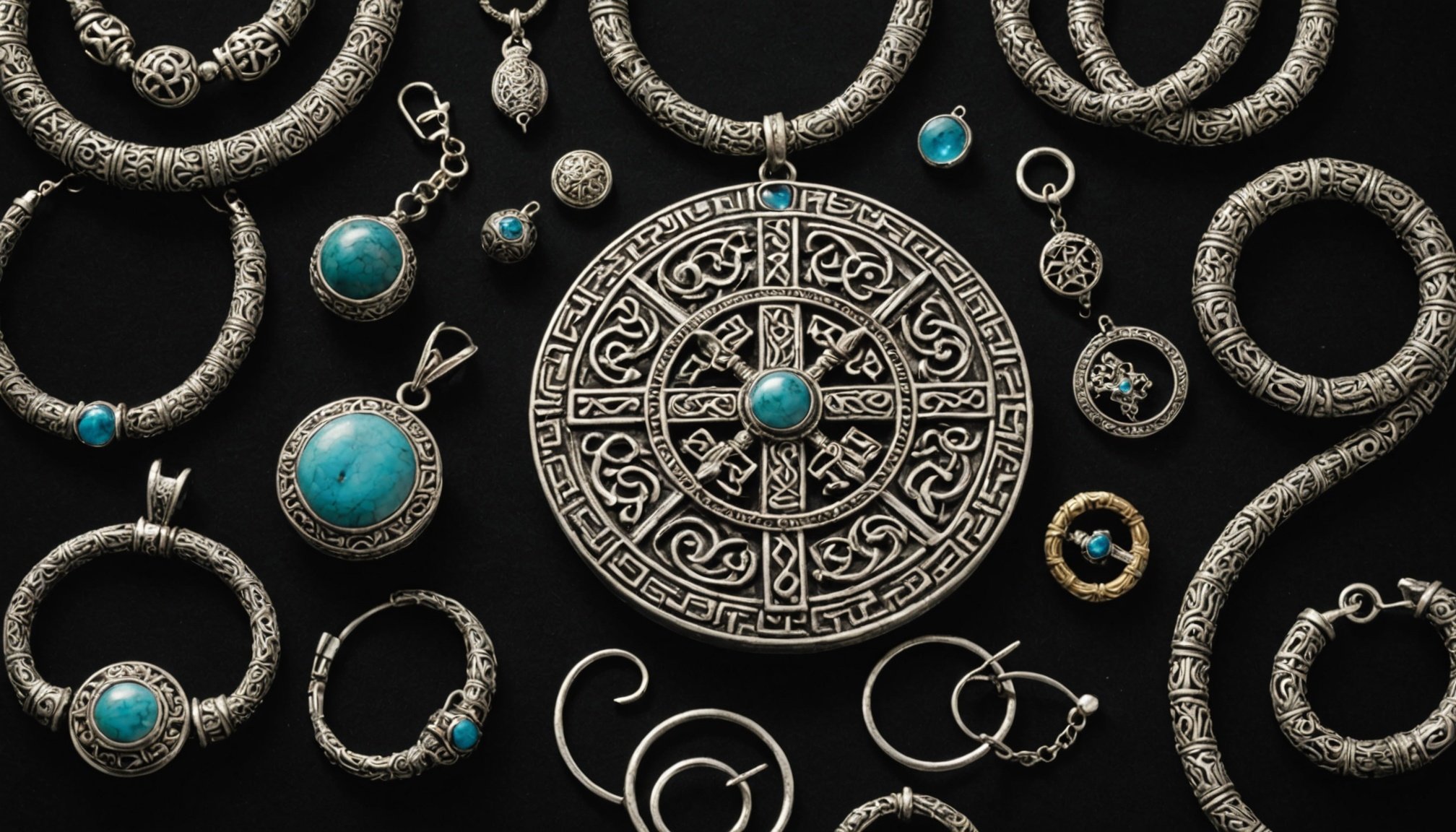Have you ever been captivated by the intricate designs and mysterious symbols of Viking jewelry? You’re not alone! The Vikings, known for their seafaring prowess and rich cultural heritage, left behind a legacy of stunning jewelry and symbols that continue to fascinate us today. In this guide, we’ll dive deep into the world of Viking aesthetic heritage, exploring the meanings behind their jewelry and symbols, and how you can incorporate these timeless pieces into your own life. Let’s embark on this journey together and uncover the secrets of the Viking age!
The allure of Viking jewelry
Viking jewelry is not just about adornment; it’s a window into the soul of a culture that thrived over a thousand years ago. The Vikings were skilled craftsmen, and their jewelry reflects a blend of practicality and artistry. From the intricate designs of brooches to the robust beauty of arm rings, each piece tells a story.
Also to read : Discover the timeless beauty of viking jewelry and symbols
Types of Viking jewelry
When we talk about Viking jewelry, we’re looking at a variety of pieces that served both functional and decorative purposes. Here are some of the most common types:
- Brooches: Often used to fasten cloaks, these were not just practical but also a status symbol. The intricate designs, such as the Oseberg style, showcase the Vikings’ artistic flair.
- Arm rings: These were worn by both men and women and often used as a form of currency. They were typically made of silver and could be quite heavy, symbolizing wealth and power.
- Necklaces: Viking necklaces often featured pendants like Thor’s hammer (Mjölnir) or the Valknut, symbols that carried deep spiritual significance.
- Rings: While less common, rings were also part of Viking adornment, often featuring intricate patterns or runes.
- Pendants: These were worn to ward off evil or to honor gods and were often made of materials like amber or glass.
The craftsmanship behind Viking jewelry
The Vikings were masters of their craft, using techniques like casting, filigree, and granulation to create their jewelry. The level of detail in these pieces is astonishing, considering the tools available at the time. For instance, the Gokstad ship burial contained a hoard of jewelry that showcased the Vikings’ ability to work with precious metals and stones.
Additional reading : Essential Insights into the Women”s Tailoring Journey in the UK
One of the most fascinating aspects of Viking craftsmanship is their use of filigree. This technique involves twisting thin wires of metal into intricate patterns, which are then soldered onto a base. The result is a delicate yet durable piece of jewelry that speaks volumes about the skill of the craftsman.
Viking symbols and their meanings
Viking symbols are more than just decorative elements; they are a language of their own, carrying deep meanings and stories. From the protective power of Thor’s hammer to the mysterious allure of the Valknut, these symbols offer a glimpse into the Viking worldview.
Thor’s hammer (Mjölnir)
Thor’s hammer, or Mjölnir, is perhaps one of the most recognizable Viking symbols. It was worn as a pendant to invoke the protection of Thor, the god of thunder. The hammer symbolized strength, protection, and the power to ward off evil forces.
As historian Neil Price notes, “Mjölnir pendants were not just decorative; they were a tangible connection to the divine, a way for Vikings to carry the power of Thor with them.”
The Valknut
The Valknut, often referred to as the “knot of the slain,” is a symbol composed of three interlocking triangles. It’s associated with Odin, the god of war and death, and is believed to represent the transition from life to death and back again.
Archaeologist Rudolf Simek explains, “The Valknut is a powerful symbol of Odin’s ability to bind and unbind, reflecting the cycle of life and death.”
The Helm of Awe (Ægishjálmr)
The Helm of Awe, or Ægishjálmr, is a symbol of protection and power. It consists of eight tridents radiating from a central point and was believed to instill fear in enemies and protect the wearer from harm.
According to the Edda, “The Helm of Awe is said to be so powerful that it could strike fear into the hearts of foes and protect the warrior in battle.”
Incorporating Viking jewelry into modern life
So, how can you bring a piece of Viking heritage into your own life? Whether you’re drawn to the symbolism or the aesthetic, there are plenty of ways to wear Viking-inspired jewelry today.
Choosing the right piece
When selecting Viking jewelry, consider what draws you to it. Are you looking for a piece that carries a specific symbol, like Thor’s hammer, or are you more interested in the craftsmanship and design? Here’s a table to help you compare different types of Viking jewelry and their modern counterparts:
| Viking Jewelry | Symbolism | Modern Equivalent |
|---|---|---|
| Brooch | Status and practicality | Pin or brooch with modern designs |
| Arm Ring | Wealth and power | Bracelet or cuff |
| Necklace with Thor’s Hammer | Protection and strength | Pendant necklace with symbolic charms |
Wearing Viking jewelry today
Viking jewelry can be worn in various ways to suit your personal style. For a more traditional look, consider pairing a Valknut pendant with a simple leather cord. If you’re looking for something more contemporary, a Thor’s hammer pendant on a silver chain can add a touch of Viking flair to any outfit.
Here are some practical tips for incorporating Viking jewelry into your wardrobe:
- Mix and match: Don’t be afraid to combine Viking pieces with modern jewelry. A Thor’s hammer pendant can look great with a simple chain or even a leather cord.
- Layer it up: Consider layering different pieces, like a Valknut pendant with a Helm of Awe bracelet, to create a unique and powerful look.
- Understand the symbolism: Before wearing a piece, take the time to learn about its meaning. This will not only enhance your appreciation but also help you choose pieces that resonate with you personally.
- Quality over quantity: Invest in well-crafted pieces that will last. Viking jewelry was made to endure, and you should look for modern pieces that reflect that durability.
- Personalize it: Many modern Viking-inspired pieces can be engraved with runes or personal symbols, adding a unique touch to your jewelry.
The cultural impact of Viking symbols
Viking symbols have transcended time and culture, influencing art, literature, and even modern-day spirituality. Their enduring appeal lies in their ability to connect us with a past that is both mysterious and inspiring.
Viking symbols in modern culture
From tattoos to logos, Viking symbols are everywhere in modern culture. The Valknut, for instance, has become a popular tattoo design, often chosen for its deep symbolic meaning. Similarly, Thor’s hammer has found its way into popular culture through movies and comics, becoming a symbol of strength and heroism.
As cultural historian Lotte Hedeager observes, “Viking symbols have a timeless quality that resonates with people today, offering a connection to a past that is both mythic and real.”
The spiritual significance of Viking symbols
For many, Viking symbols hold a spiritual significance that goes beyond mere decoration. They are seen as a way to connect with the gods and the natural world. The Helm of Awe, for example, is often used in modern pagan practices as a symbol of protection and power.
Spiritual author Diana Paxson writes, “The symbols of the Vikings are not just historical artifacts; they are living symbols that continue to inspire and guide those who seek a deeper connection to the divine.”
The world of Viking jewelry and symbols is a rich tapestry of history, art, and spirituality. By understanding and appreciating these elements, we can not only connect with our past but also bring a piece of that heritage into our modern lives. Whether you’re drawn to the protective power of Thor’s hammer, the mysterious allure of the Valknut, or the intricate craftsmanship of Viking jewelry, there’s something in this ancient culture for everyone.
So, next time you see a piece of Viking-inspired jewelry, take a moment to appreciate the stories and symbols it carries. And who knows? You might just find yourself drawn into the fascinating world of Viking aesthetic heritage.











